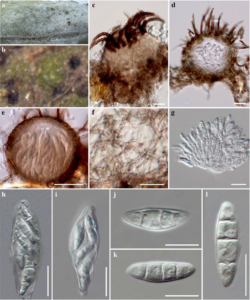Trichomerium siamensis Hongsanan & K.D. Hyde,.
Index Fungorum number: IF631665, Facesoffunginumber: FoF 00395; Fig. 1
Etymology – siamensis is from Latin derived from siam + ensis which means “of Siam” or “Thailand”.
Holotypus – MFLU 14–0750.
Saprobic on the lower surface of leaves. Superficial hyphae 3 – 4μm wide, septate, constricted at the septum, pale brown to brown. Sexual morph Ascomata 112– 130 μm diam. (x̄ = 126 μm, n = 5), superficial, mostly solitary, subglobose, rounded above, light brown, ostiolate, held to the leaf surface by basal mycelium, with apical setae. Setae 38 – 56 × 4 – 5 μm (x̄ = 48 × 4 μm, n = 10) at upper part of ascomata, larger and rounded at the base, curved, dark brown to black. Peridium 9 – 14 μm (x̄ = 10 μm, n = 5), comprising two-layers of cells of textura angularis, outer layer composed of pigmented, thickwalled cells of textura angularis, inner layer composed of pale, pigmented and thin-walled cells of textura angularis. Hamathecium lacking paraphyses. Asci 48 – 64 × 14 –21 μm (x̄ = 62 × 17 μm, n = 5), 8 – spored, bitunicate, broadly cylindrical or oblong, usually with short pedicel. Ascospores 20 – 23 × 6 – 7 μm, (x̄ = 21 × 6 μm, n = 10), to tri-seriate, oblong to ellipsoid, 3 – septate, not constricted at the septum, end cells narrow and smaller than central cells, hyaline, wall slightly roughened. Asexual morph Undetermined.
Material examined – THAILAND, Chiang Rai, Tasud, on leaves of Tecoma sp. (Bignoniaceae), November 2011, S. Hongsanan HSA09 (MFLU 14–0750, holotype); ex-type living culture, MFLUCC 12–0097, CPC 20469. GenBank ITS: KP744468.
Notes – This new taxon is similar to other species of Trichomerium (Trichomeriaceae) based on its superficial ascomata on the surface of leaves, and dark setae on the upper part of ascomata (Chomnunti et al. 2014). Trichomerium siamensis is most similar to T. ornatum based on ascospore shape and septation, but differs in having short setae at the upper part of ascomata in T. siamensis, while ascomata have long setae in T. ornatum. Moreover, T. siamensis is also similar to T. criniporum due to the ascomata with setae and shape of ascospores, but differs in having setae with septa, while setae are aseptate in T. criniporum. Molecular analysis (ITS) supports the fact that T. siamensis is the new species in Trichomerium with 91 % ML and 100 % BP support.

Fig. 1 Trichomerium siamensis (holotype) a, b Ascomata on lower surface of leaf c Dark setae clustered at the apex of ascomata d Section through ascomata showing asci arrangement e Peridium and ascus arrangement f Mycelium on surface of leaves g Asci embedded in gelatinous matrix h, i Asci j – l Ascospore with 3 – septa. Scale bars: c, d, h,i = 20 μm, e, g = 50 μm, f, j, k, l = 10 μm.
